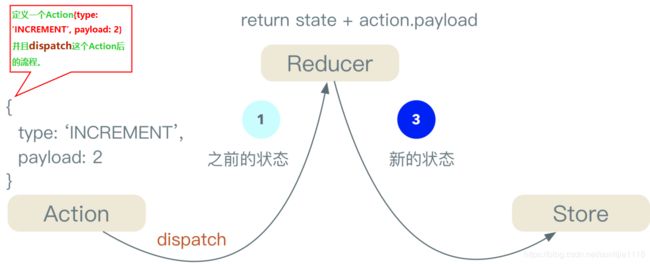Redux
转载:https://www.cnblogs.com/tarena/p/8473961.html
Redux是为了解决应用程序状态(State)管理而提出的一种解决方案。对于应用开发来讲,UI上显示的数据、控件状态、登陆状态、数据加载画面的不同状态等等全部可以看作状态。
Redux 的三个概念:Reducer、Action、Store。
Store 一般负责:保存应用状态、提供访问状态的方法、派发Action的方法以及对于状态订阅者的注册和取消等。(可以理解成内存数据库)。
Reducer 其实就是用来维护状态的。reducer就是对数组元素进行累加计算成为一个值。(可以理解成数据库表,但这种说法不太精确)。
Action 在Redux规范中,所有的会引发状态更新的交互行为都必须通过一个显性定义的Action来进行。(Reducer和Store之间的通信靠Action)。
注意:
export interface Action {
type: string;
payload?: any; // 这个值可有可无
}ngrx是一套利用RxJS的类库,其中@ngrx/store就是基于Redux规范制定的Angular2框架。
@ngrx/store
RxJS 基于Redux的设计思想,为Angular应用提供强有力的状态管理工具。
@ngrx/store是一个旨在提高写性能的控制状态的容器,在angular的应用程序上是一致的。
核心:
- State是一个不可变的数据结构
- Action描述State的改变
- Reducer(纯函数)拿到下一个State和之前的State来计算一个新的State
- 通过Store访问State,一个可观测state和一个actions观察者
安装使用:npm install @ngrx/store --save 或 yarn add @ngrx/store
State 与 Angular的Component的关系
- State驱动Component进行渲染(this.store.dispatch)
- Component发action来改变State
@ngrx/effects
@ngrx/effects 提供一套API(装饰器@Effect( )和Action)来帮助检查Store.dispatch( )出来的Action。将特定类型的Action过滤出来进行处理,监听特定Action,当发现特定的Action发出之后,自动执行某些操作,然后将处理的结果重新发送回store中。
核心:
- 监听派发出来(@ngrx/store 的Store.dispatch)的Action
- 隔离业务和组件(Component只通过select state 和 dispatch actions即可)
- 提供新的reducer state(基于网络请求、web socket 消息 或 time事件驱动[定时刷新])
安装使用:npm install @ngrx/effects --save 或 yarn add @ngrx/effects
Effects 通常注入到service类
注册Effect
EffectsModule.forRoot( ) 必须在根模块下注册,如果不需要注册任何根级别的Effect,可以Provider一个空数组。
//app.module.ts
@NgModule({
imports: [
EffectsModule.forRoot([
SourceA,
SourceB,
SourceC,
])
//EffectsModule.forRoot([]) //提供一个空数组
]
})
export class AppModule { }
EffectsModule.forFeature( )可以在任何ng模块使用(导入)EffectsModule.forFeature(),无论是根模块(AppModule),还是任何一个功能模块。
//feature.module.ts
@NgModule({
imports: [
EffectsModule.forFeature([
FeatureSourceA,
FeatureSourceB,
FeatureSourceC,
])
]
})
export class FeatureModule { }
Init Action
import { Injectable } from '@angular/core';
import { Actions } from '@ngrx/effects';
@Injectable()
export class SomeEffectsClass {
constructor(private actions$: Actions) {}
}
示例:
import { Action } from '@ngrx/store';
import { Actions, Effect } from '@ngrx/effects';
import { defer } from 'rxjs/observable/defer';
import * as auth from '../actions/auth.actions';
@Injectable()
export class AppEffects {
@Effect()
init$: Observable = defer(() => {
return of(new auth.LoginAction());
});
constructor(private actions$: Actions) { }
}
ofType
import { Injectable } from '@angular/core';
import { Actions, Effect, ofType } from '@ngrx/effects';
import { tap } from 'rxjs/operators';
@Injectable()
export class SomeEffectsClass {
constructor(private actions$: Actions) {}
@Effect() authActions$ = this.action$.pipe(
ofType('LOGIN', 'LOGOUT'),
tap(action => console.log(action))
);
}
@ngrx/router-store
通过@ngrx/store绑定连接angular路由
安装使用:npm install @ngrx/router-store --save 或 yarn add @ngrx/router-store
/**
* Payload of ROUTER_NAVIGATION.
*/
export declare type RouterNavigationPayload = {
routerState: T;
event: RoutesRecognized;
};
/**
* An action dispatched when the router navigates.
*/
export declare type RouterNavigationAction = {
type: typeof ROUTER_NAVIGATION;
payload: RouterNavigationPayload;
};

